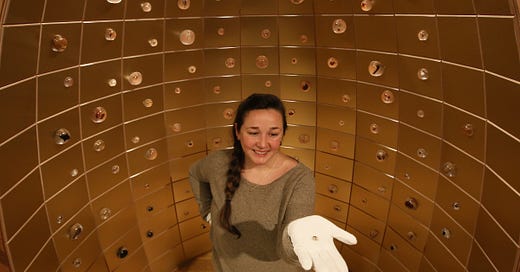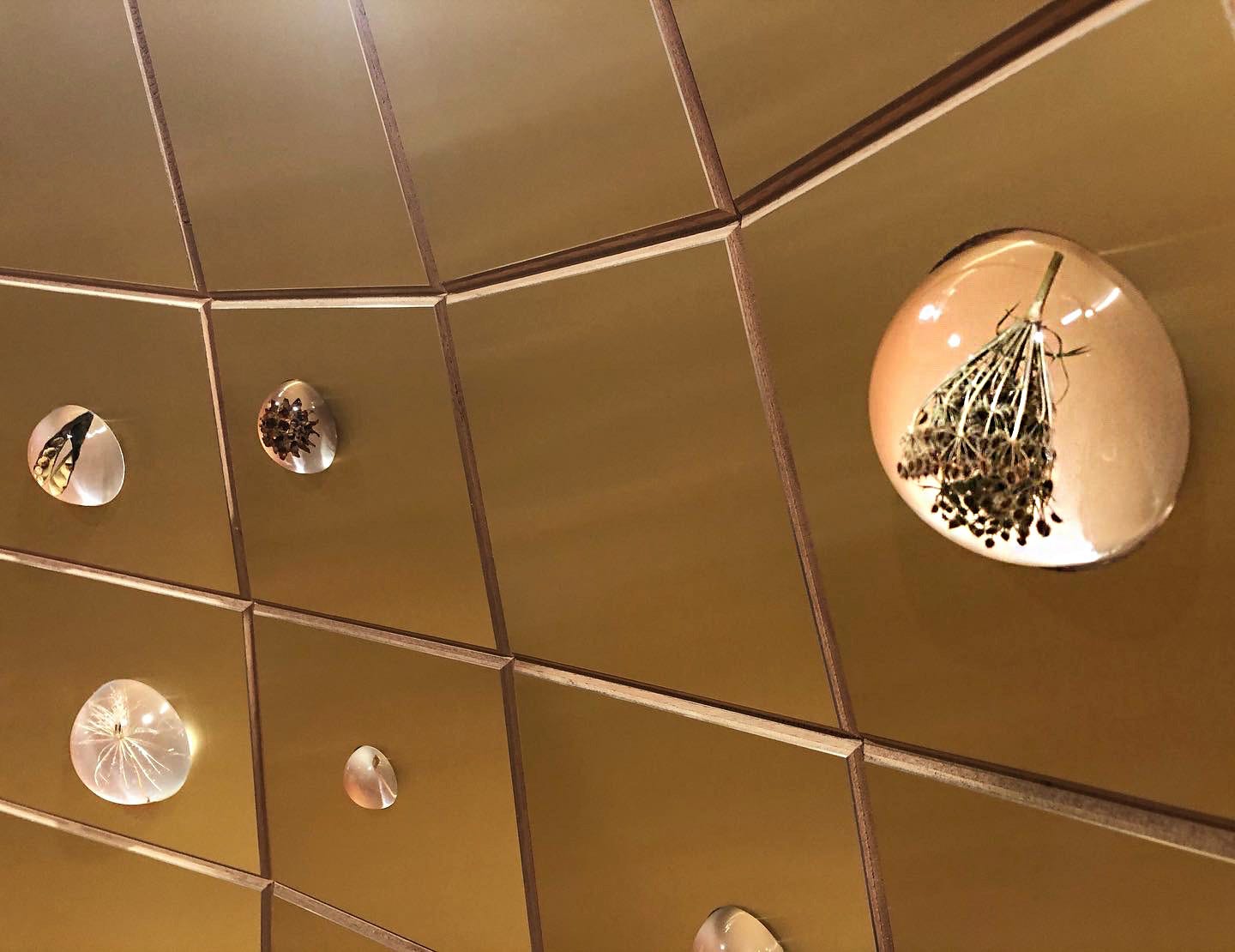Discovering the magic and power of seeds
Heirloom, an exhibition devoted to seeds, sees artist Rachel Doolin grapple not only with plant stories but human stories too: what can we learn from the diversity and abundance of the plant world?
“Life has bubbles”
When artist Rachel Doolin was busy working in the National Sculpture Factory on a piece she would title Seedarium, she ran into a frustrating problem.
Working with plant seeds sent to her by an extensive network of gardeners and growers and members of Irish Seed Savers, she was setting the seeds into hemispheres of clear epoxy resin. But more often than not, bubbles of air were mysteriously appearing in the resin as it set. She wanted them perfect, and this wasn’t good enough.
One day she was talking to Debbie Gillies of Northern Ireland plant conservation charity True Harvest Seeds and she mentioned the problem she’d been having.
“Debbie told me that seeds are always breathing,” Rachel says. “Even when they are dried for storage, they are still taking tiny little breaths. And I went, ‘oh no wonder I can’t get the bubbles out of my resin!’”
“So we came up with this saying: Life Has Bubbles. That fact became part of it, and I was suddenly completely accepting of these bubbles that had been really frustrating. As soon as I learned that, I thought, ok, that’s perfect.”
The resulting Seedarium is a sculpture large enough that viewers can walk into: it was inspired, she tells me by a visit to the Sanctuary of the Virgen de la Esperanza in Calasparra in southern Spain: the Sanctuary of Hope. And if there’s hope there, it’s in the miraculous diversity and abundance of the world of seeds.
There’s a growing global awareness of the importance of preserving what is often called “heirloom” seed: varieties of plant food crops that may not be conducive to modern industrial farming techniques or to long-chain food systems, but whose presence in our gardens and farms and on our plates is a vital protection against monocultures vulnerable to disease and changing climates.
For Heirloom, Rachel found herself tapping into a network of seed savers devoted to the work of preserving seed heritage, both in Ireland and globally.
Although she didn’t know it at the time, Rachel’s six-year journey towards her current exhibition began with a visit to the Global Seed Vault in Svalbard in Norway. Buried in the permafrost of the Arctic, the Global Seed Vault is a repository for plant genetic material in the form of seeds: they currently have 1,214,827 seeds in storage.
A photo of the building, called The Weight of Mountains, is included in Heirloom. But at the time, Rachel’s primary interest in Svalbard was not in the idea of the seeds themselves. It needed time to germinate, and it would come later, via a series of encounters and experiences.
It finally came to fruition with a bowl of tomatoes in West Cork.
She went to visit botanist and small farmer Madeline McKeever, founder of Brown Envelope Seeds near Skibbereen. “Darina Allen and Jennifer McConnell from Irish Seed Savers showed up to have lunch, and the lunch was a bowl of tomatoes of all different varieties and it was the first time I had tasted all of these amazing varieties,” Rachel says. “It was like a scene from Willy Wonka. I was going, ‘oh, it’s sweet, oh this one’s so savoury.’ And then I had this feeling of anger and disappointment: why is this not available to us? Why do we have these unripe, tasteless tomatoes?”
Madeline also told Rachel the story of the aptly named Rhoda Cutbush, who found a few dried beans in the back of her shed, sowed them, and realised that she had rediscovered a variety of red-flowered broad bean grown by her father, which had been presumed extinct.
“She understood the value of her own discovery, and she sent it to the heritage seed bank in England and they were able to revive the variety,” Rachel says. “That just really made me think about how the story of seeds is the story of ordinary individuals. You can have seed banks all over the world, but the real seed banks are in people’s gardens.”
Taking root with little peas
Rachel ended up doing a residency at Irish Seedsavers in Co Clare, interviewing botanists, scientists and seed savers from around the world for her SeedCLOUD installation, which has an interactive audio element described below, and accepting seed donations in their hundreds for her Seedarium.
Although she doesn’t describe herself as a community artist, there is often a collaborative element to Rachel’s work.
“As well as being hard work, it’s quite a beneficial way to work because you get other input and ideas into the work as well,” she says. “It kind of takes a little bit of the personal thing out of it: I feel the responsibility that I am creating work with other people involved, and I’m actually quite a shy and self-conscious person. Working in that collaborative way takes the load and focus off me and it becomes more of a group effort.”
One spin-off from her work on Heirloom really took root, even picking up a Lifelong Learning Early Years award in 2022: during Covid lockdowns, in collaboration with Graffiti Theatre Company’s Beag preschool programme, Rachel devised an educational programme called Little Peas, which teaches young children about sowing, growing and caring for Irish Pea Plants donated by Irish Seedsavers. The project started small, but has really grown legs: this year, 16 early learning centres are going to be working with the Little Peas programme.
As much as Heirloom has been about seeds, Rachel says, it’s also “about that connection: when I was receiving the words along with the seeds, that was the connection for me. That’s where that power is, in the advocacy for continued guardianship.”
“Greg Schoen said that to truly embrace biodiversity, we need to embrace all the colours of the rainbow,” she says. “I think that’s so true, and that we have a lot to learn from all that abundance and variety, and how we’ve run into the problem because of this human habit of selecting things. We select crops for their yield and what they can do for us, without considering the whole ecosystem they function in.”
Three mind-blowing seed stories shared as part of Heirloom
Heirloom’s interactive installation SeedCLOUD is comprised of a series of small bowls of seeds: gallery-goers can hold their phone over each bowl and an NFC (Near Field Communication) tag will take them to an audio file to hear the story of the seeds, stories that interweave plant genetics with thousands of years of human culture and innovation. Here are three of the stories:
Listen: Red Space Lettuce
The first plant crop ever grown in space was a Romaine lettuce variety called Outredgeous. It was grown and eaten by NASA astronauts in a specially designed Veggie System. Rachel interviewed Life Sciences Project Scientist Gioia Massa, who works at Kennedy Space Centre, about the evolution and future of space farming.
Listen: Cherokee glass gem corn
Carl Barnes from Oklahoma, a horticulturalist of Cherokee and Irish descent, gave a curious rainbow-coloured corn variety to seed keeper Greg Schoen, who recounts his story: although modern farmers were intent on breeding white or yellow corn, Carl didn’t regard the brightly coloured kernels that sometimes emerged as something annoying to be discarded, but as a sacred connection to native peoples’ culture and way of life.
“Often they would have these other colours appear: bright reds and oranges, or purples. They referred to that as ‘Indian Corn’ and so they discarded it and fed it to their animals and kept selecting for yellow and white corn. Carl, on the other hand, took an interest in them. He called them ‘the old ones.’ When certain ones would show up, Carl would recognise them as a variety that a certain tribe had lost. Over the years, that’s what he would become known for: returning the maize to the tribes that had lost them.”
Listen: Syrian white courgettes saved from war
In 2010, a Syrian refugee donated seeds from a variety of white courgette to Irish Seedsavers in Co Clare. In 2014, a Syrian seed bank rushed to send shipments of over 100,000 varieties of seeds to the Global Seed Vault in Svalbard because they feared that their own seed bank would be destroyed in the war in their country. Later, they enlisted the help of other countries to sow crops and continue to preserve their seed lineages. Wired journalist and science writer Matt Simon, who wrote an article called These Rare Seeds Escaped Syria’s War to Help Feed the World, shares the story with Rachel.
Heirloom by Rachel Doolin opens at 6pm on Thursday, March 30 and runs until Thursday April 27 at the LHQ Gallery, Cork County Library, Carrigrohane Road.






